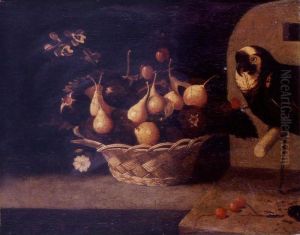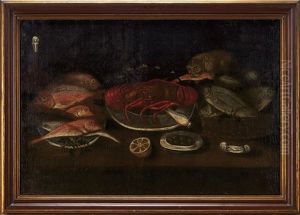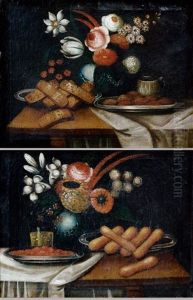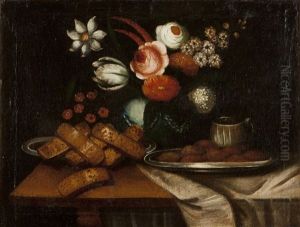Baltazar Gomes Figueira Paintings
Baltazar Gomes Figueira was a significant Portuguese painter from the 17th century, born in Óbidos, Portugal, in 1604. His work is often associated with the Baroque period, a time characterized by dramatic expression, detail, and grandeur in the arts. Figueira's contributions to art are particularly noted for their detailed still lifes, a genre that gained prominence during his lifetime. His paintings are remarkable for their intricate detail, vivid color, and the ability to convey the texture of the subjects he portrayed, ranging from kitchen scenes to more elaborate compositions of flowers and game.
Figueira's life and career were deeply intertwined with the cultural and artistic milieu of the Iberian Peninsula during a period of significant historical events, including the Portuguese Restoration War, which led to Portugal's independence from Spain in 1640. Despite the tumultuous times, Figueira's career flourished, partly due to the patronage he received from the Portuguese nobility and religious institutions, which were significant art patrons during the Baroque period.
Interestingly, Baltazar Gomes Figueira was part of an artistic family. His daughter, Josefa de Óbidos, became one of the most renowned female painters of the time, known for her religious works, still lifes, and portraits. This familial connection highlights the role of artistic dynasties in the Baroque era, where the transmission of skills and artistic sensibilities often occurred within families.
Throughout his career, Figueira developed a style that, while reflective of the broader trends in Baroque art, also possessed unique qualities that set his work apart. His attention to detail, use of light, and composition skills are evident in his still lifes, which often included elements symbolizing the transience of life, a common theme in Baroque art known as 'vanitas.'
Baltazar Gomes Figueira's legacy is preserved in various Portuguese institutions and collections, showcasing the enduring appeal of his works. His death in 1674 marked the end of a significant career, but his influence continued, particularly through the works of his daughter, Josefa, and other Portuguese artists of the period. Figueira's art remains a vital part of the study of the Baroque period in Portugal, reflecting the rich cultural and artistic heritage of his time.



